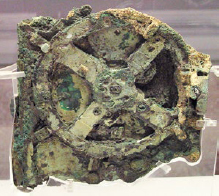c. 100 BCE
First Computer
Sometime near the end of the first century BCE, a Roman ship carrying a large supply of ancient Greek artifacts sank in the Mediterranean, off the coast of the Greek island of Antikythera. Two thousand years later, in 1901, divers came across the wreck and discovered, among the artifacts, the corroded remains of what may be the world’s oldest computer, now known as the Antikythera mechanism.
At first archaeologists thought that the mechanism might have been a mechanical clock because of its dozens of small gears. This would have been an amazing find in its own right, because the workmanship was said to be comparable to mechanical clockwork in seventeenth-century Europe. But after decades of cleaning and additional study, the device was discovered to be much more than a clock; it appears to have been a sophisticated mechanical astronomical computer and calendar that could be used to determine the past and future positions of the Sun, Moon, and planets in the sky, to predict eclipses, and to display the phases of the Moon. It is the oldest (by 1,500 years!) example of an orrery, a clockwork-like planetarium model of the solar system, superbly designed and built.
The discoveries about this device are remarkable on so many levels. They reveal an extremely precise and detailed knowledge of planetary motions by the ancient Greeks, including subtle variations in the Moon’s velocity over the course of each month. The flawlessly worked mechanisms suggest that many of these devices had been built, and the compact size suggested that they were intended to be portable.

One of the surviving fragments, recovered in 1901 from an ancient Greek shipwreck.
We are accustomed to technological advances and scientific discoveries being closely linked in the modern world, so perhaps it should not be surprising to learn that the same appears to have been true in ancient Greco-Roman times. Still, it is both humbling and jarring to discover evidence, from a single artifact, that a civilization was far more technologically advanced than we had thought before.
SEE ALSO Ancient Observatories (c. 3000 BCE), Finding Easter (c. 700).
A modern reconstruction of the Antikythera mechanism, based on detailed study and analysis of the badly damaged remaining fragments.
